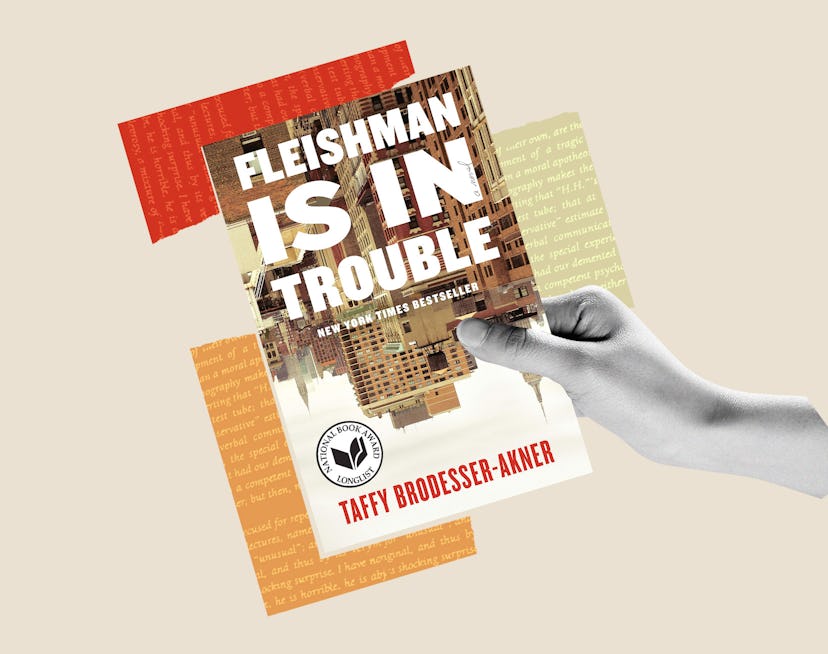Books
Taffy Brodesser-Akner Can Write Anywhere — Even The Bathroom At Bloomingdale’s
The author of Fleishman Is in Trouble — and the showrunner of its FX adaptation — is nothing if not adaptable.

Buried deep in a box in Taffy Brodesser-Akner’s house is a script she wrote while studying screenwriting at New York University. Though she hasn’t revisited the aging document in decades — “If I turned the page, it would crack,” she jokes — Akner can still recall the particulars of her senior thesis. “It was about a group of college-aged boys who wanted to be considered ‘serious people’ in the world. They start doing heroin because they get invited to some sort of literary party where people are doing heroin, and then there’s a dead woman,” Akner tells Bustle. “My problem was that I had this idea for these characters, not necessarily for a story. And because I wasn’t immediately successful at [screenwriting], I assumed I was bad at it.”
It would take Akner, who is now the author of the book Fleishman Is in Trouble and the showrunner of its FX adaptation, more than two decades to learn that she is not, in fact, bad at screenwriting. First, she’d pursue a career in writing for magazines, eventually becoming known for her narrative-driven, introspective profiles on everyone from Kris Jenner to Nicki Minaj. “When I started writing journalism, I was able to [use] the things I knew about storytelling,” she says. “I don’t think [storytelling] is a thing that’s taught to journalists. To tell a story with a beginning, a middle, and an end.” That same skill prepared Akner to write her New York Times bestseller, which tells the story of Toby Fleishman, a man whose life is turned upside down when his ex-wife drops their children off at his apartment for the weekend and fails to ever pick them up.
But despite the novel’s massive success, when Akner was first approached about showrunning the TV adaptation of her book, she balked. “In my head, I was like, ‘Oh, I already know I’m not good at that.’ And my producing partners were like, ‘Are you sure? Because it sounds like you tried it once when you were 21.’” Akner ultimately relented, writing seven out of the eight episodes herself — a choice that reignited her passion for her first love and taught her a valuable lesson. “I hope that everyone remembers always the thing I have to remind myself, which is: The stakes are pretty low. It’s just you and your computer — you should try anything.”
Below, Akner reflects on the nature of writer’s block, her love of “withering” books, and treating herself to a trip to the movies.
On the book that’s commanding her attention:
I’m reading a book called Vintage Contemporaries by Dan Kois. It’s his first novel, and it’s one of the first things [in a while] that I’ve been able to concentrate on that I’m not reading to write a book review or something. It’s a coming of age story that starts in the ’90s and continues into the millennium. It’s soft, beautiful, brave, withering, and everything I want in a book.
On taking her own advice:
I’ve said in the past that I don’t believe in writer’s block, but actually saying that is my willful way of not believing in writer’s block. I had a very horrible bout of it this year, and I remembered advice I once gave to someone: “Write the next sentence. Twenty sentences later, it might be good.” I feel like the rut comes when you’re not writing — when you stop writing, and then you’re thinking about the fact that you stopped writing. The minute I admitted I was in a rut, the rut became bigger.
On the power of a midday movie:
If I’m smart and I recognize [I’m in a rut] early on, I go to the movies. If I go to the movies, I come out and feel like the most privileged person in the world because not many people can go to the movies during the day. I hear people saying that if you think really hard about something and then go take a shower, it resolves itself. But showers are so much work sometimes. Movies are so much fun.
On learning to use an actual desk:
I can write anywhere. I can write from the Bloomingdale’s bathroom that has a couch. I can write from the airplane while my children straddle me. However, because of [the pandemic], I’ve had to have a place [I write at]. I have a motorized standing desk. It’s my indulgence, and I rarely stand up at it, but I always know I can. It has a million things on it: three meaningful mugs, a spiral notebook that’s on top of the spiral notebook that I forgot was already there. Right now it has two large speakers so that when I can’t be in L.A. for a sound mix, I can hear what it sounds like. And it has some Post-its that are held on a formal Post-it holder with my initials on it, that one of my students gave me once that I treasure.
This interview has been edited and condensed for clarity.
This article was originally published on